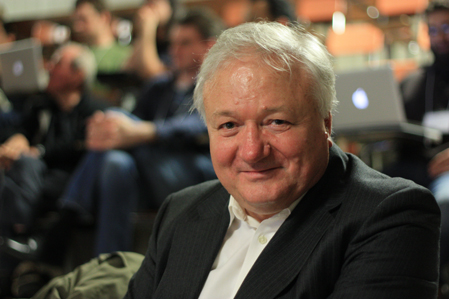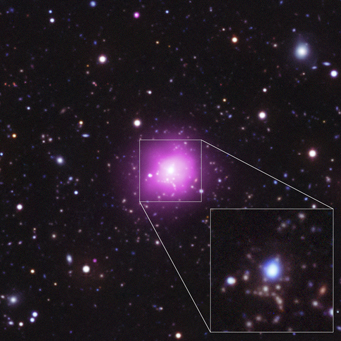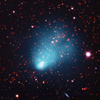Disclaimer: This material is being kept online for historical purposes. Though accurate at the time of publication, it is no longer being updated. The page may contain broken links or outdated information, and parts may not function in current web browsers. Visit chandra.si.edu for current information.
The Prediction and Fulfillment of the "Effect": An Interview with Rashid Sunyaev
August 15, 2012 ::
by Peter Edmonds
Few areas of cosmology and high-energy astrophysics have not been influenced by the work of Rashid Sunyaev, one of the most distinguished and highly respected scientists in these fields. One outstanding contribution has been the prediction of the Sunyaev-Zeldovich (SZ) effect, named after Sunyaev and his Russian mentor, Yakov Zeldovich. In this phenomenon, photons in the cosmic microwave background (CMB), the radiation remaining after the Big Bang, interact with electrons in the hot gas that pervades galaxy clusters. The photons acquire energy from this interaction, which distorts the signal from the CMB in the direction of the clusters. The SZ effect is now being used to find large numbers of galaxy clusters, using observatories such as the South Pole Telescope and the Atacama Cosmology Telescope. The Phoenix Cluster is one example of these newly discovered objects.
We have had the pleasure of interviewing Sunyaev, to ask about some of the history behind the discovery of the SZ effect -- or the "effect" as he modestly calls it -- and to seek his thoughts on the Phoenix Cluster and other results that have capitalized on this phenomenon. He also comments on dark energy, one of the biggest mysteries in physics, and discusses some prospects for future developments in astrophysics.
Sunyaev received a Candidate of Sciences degree, the equivalent of a PhD, in astrophysics from Moscow State University in 1968 and a Doctor of Sciences degree in astrophysics from Moscow University in 1973. He has won many awards during his career, including the Kyoto Prize and Gold Medal from the Inamori Foundation in 2011, the Benjamin Franklin Medal in Physics from the Franklin Institute in 2012, and other awards too numerous to list here. Sunyaev currently holds several prestigious positions, including Director of the Max-Planck Institute for Astrophysics, and Chief Scientist at the Space Research Institute of the Russian Academy of Sciences.
Q: Your prediction, along with Yakov Zeldovich, that galaxy clusters would show the SZ effect was originally met with skepticism by your colleagues. How satisfying has it been to not only see your prediction confirmed, but to witness the use of the SZ effect become a vital part of modern astrophysics?
A: Yes, when I was presenting my first talks about the effect, some physicists were skeptical because they thought that the diminution of the sky radio brightness in the direction of a cloud of very hot gas contradicts the laws of thermodynamics. Astronomers were very skeptical when I told them that the strength of the effect and its spectrum don't depend on the redshift, a measure of the distance to an object. This contradicted all the experience of extragalactic astronomy. It was great when I was being harshly criticized, that my mentor, Yakov Zeldovich, would appear on the scene and say: "Rashid is correct". And that in itself was a miracle. Everyone immediately agreed. At that time I realized how good it is to have heavy artillery behind you.
At the same time I wasn't very happy because Zeldovich thought that the effect was too weak and would possibly never be observed. I was young and always believed that if the physics are correct then the Universe will find a way to demonstrate this effect. I am very grateful to the people who believed this idea and spent many years trying to detect it, but the real confirmation began to arrive only at the end of the 1980s and the beginning of the 1990s, 20 years after the effect was proposed. A great moment for me was when I saw the paper by a radio astronomer from Chicago, John Carlstrom, together with his colleagues, reporting the results of Berkeley-Illinois-Maryland Association interferometer observations of the effect in the direction of clusters at different redshifts from z=0.17 up to z=0.888. But obviously, it was impossible to even dream in 1969, when I first started to write about the effect, that today the South Pole Telescope, the Atacama Cosmology Telescope and the Planck spacecraft would discover more than a thousand previously unknown clusters of galaxies on the blank sky. It's a tremendous feeling to realize that the majority of these clusters have very high redshifts and the effect now permits us to look for the most massive clusters in our Universe. It's also very difficult to imagine that these clusters, discovered due to the effect, will be observed on the sky during the next billions of years. And there is the very big question: Will there still be astronomers on the Earth at such a distant point in time?
At the same time, I'm very sad that Yakov Zeldovich is unable to observe today this flow of new papers and the exciting data coming from the observations of newly discovered sources in different spectral bands. [Editor's note: Zeldovich passed away in December 1987.]
Q: Can you please give your thoughts on the paper describing the discovery of the Phoenix Cluster by McDonald et al., including your opinion on its significance?
A: This is an extremely interesting paper. There was a very significant problem of why we couldn't observe cooling of the gas -- because the characteristic cooling time in the central parts of many clusters is significantly shorter than their age. The recently discovered great Phoenix cluster demonstrates that there was a period in the life of many rich clusters of galaxies when the cooling flow existed and led to the intense star formation in the dominant central galaxy of a cluster. Continuing to look for similar phenomena on the whole sky, we have a chance to understand how long these periods lasted.
Q: Do you think it's more likely that the cluster passes through the observed phase of strong cooling multiple times or whether the authors have caught a unique event over its lifetime?
A: I, myself, believe that clusters pass through phases of strong cooling several times in their lifetimes. The authors were lucky to catch a unique and tremendously strong star formation event due to the strong cooling flow.
Q: Other interesting objects have been found with the SZ effect, such as El Gordo, which was discovered with the Atacama Cosmology Telescope. Are you hopeful that studies of the most massive and distant clusters can provide strong tests of the standard model of cosmology and perhaps even probe the nature of the very early Universe?
A: I believe that clusters like Phoenix and El Gordo, similarly to the Bullet Cluster, are able to give us a lot of information about the physical processes in the most massive objects of our Universe. Such clusters are unique laboratories of high temperature plasma physics. They are characterized by huge concentrations of dark matter, and they are objects with extreme gravitational potential, leading to strong gravitational lensing. And obviously, every discovery of such massive clusters can provide strong tests of the standard model of our Universe, which predicts that not too many of them exist at high redshifts. The continuation of these studies and the whole sky surveys might still lead to unpredictable results and check how good is our understanding of the nature of the spectrum of primordial density perturbations.
Q: There is a large, ongoing Chandra program to observe dozens of galaxy clusters discovered by SPT, led by Brad Benson. One of their goals is to continue the work led by a colleague of yours, Alexey Vikhlinin, to use the growth of structure as a probe of cosmology and the nature of cosmic acceleration. Are you optimistic that studies like this might give genuine hints about the nature of dark energy or of the behavior of gravity over cosmological scales?
A: It's my impression that Chandra X-ray Observatory data today are extremely important for cosmological studies using galaxy clusters. Chandra observations open up ways to measure the masses of newly discovered clusters. We need to know their masses to do real cosmology. The papers of Alexey Vikhlinin and his coauthors demonstrated that the growth of the large-scale structure of the Universe is an excellent probe of cosmology. I am very glad that bright young scientists, like Brad Benson, are joining these efforts. The comparison of observational data with the data obtained in numerical simulations is a huge help in allowing us to go ahead.
I have no doubts that observational cosmology of the next 20-25 years will provide us with a full understanding of the general properties of dark energy, but I don't know if its nature can be fully understood in such a short time.
Q: You continue to be very active in research. For example, at the time of writing you have co-authored about 20 papers, just in 2012 alone, which are either published or submitted for publication. Do you have a particular topic or topics in astrophysics that you find more interesting than others? What future work or new developments are you especially excited about?
A: I am very happy to live today in a time when an enormous revolution in observational astrophysics and cosmology continues so successfully. A lot of excellent new ground-based optical and radio telescopes and space observatories will be operational within the next 5-10 years. It's wonderful to wake up in the morning and almost every day find something great and extremely interesting coming in the new preprints, written by an active and very strong generation of young astrophysicists. I'm very interested today in observational methods permitting us to obtain additional information about the properties of our Universe, when it was thousands and millions of times younger than today. It will be tremendous if these new methods will permit at some point, maybe after tens of years, the direct detection of photons from the cosmological recombination of hydrogen, which occurs at redshift 1500, and to prove the existence of the black body photosphere of our Universe, which was able to create the CMB ideal black body spectrum at redshift close to two million. I believe that new generations of space projects will permit such observations, but this will be in the relatively distant future. However, even in the coming years we will certainly get a lot of new information about the great epoch of the reionization of the Universe which occurred at only redshift 10, or when the Universe was only 30 times younger than today.
Disclaimer: This material is being kept online for historical purposes. Though accurate at the time of publication, it is no longer being updated. The page may contain broken links or outdated information, and parts may not function in current web browsers. Visit chandra.si.edu for current information.








